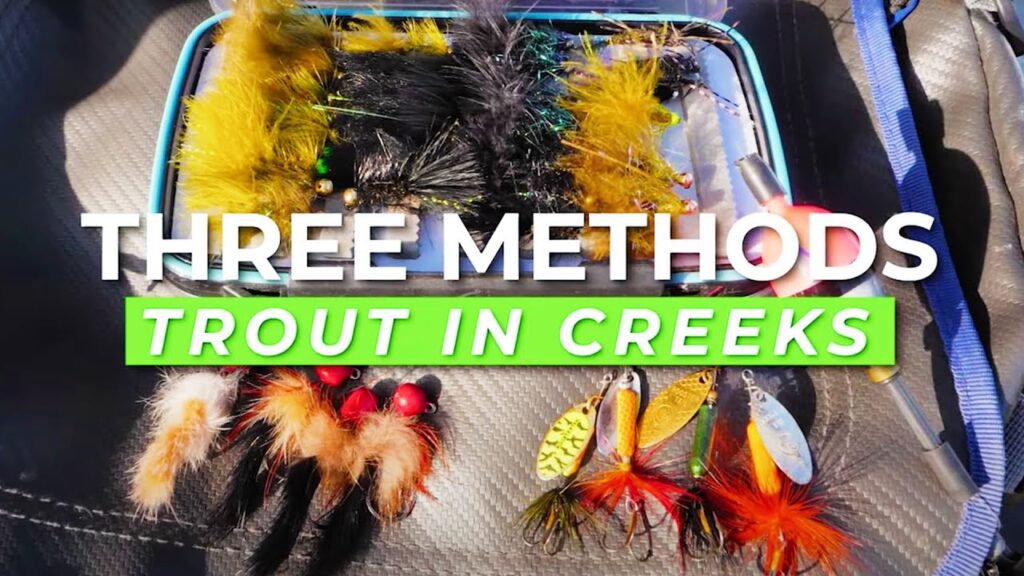In the video titled “TOP 3 Trout Fishing Setups For Creeks & Rivers” by Addicted Fishing, they discuss the top three trout fishing setups that are effective in creeks and rivers. The first setup they discuss is spinners, which are known for attracting trout with their spin and flash. They provide tips on spinner types, colors, retrieval techniques, bait or lure selection, rigging, and twitching techniques. The video also explores the float and worm or float and fly setup, which is a versatile approach for enticing trout. Finally, they delve into the art of twitching jigs, an effective technique for mimicking natural prey and triggering aggressive strikes from trout. The video offers tips on jig selection, rigging, and twitching techniques. It aims to provide valuable information to increase viewers’ chances of success in trout fishing in creeks and rivers.

Overview of Trout Fishing Methods
Table of Contents
Trout fishing is a popular sport enjoyed by many anglers, and there are various methods and techniques that can be utilized to increase your chances of success. In this comprehensive article, we will explore the different fishing methods for trout, discuss the benefits of each method, and provide tips and techniques for maximizing your catch. Whether you are a beginner or an experienced angler, this guide will provide valuable insights and strategies to enhance your trout fishing skills.
Spinner Setup for Trout Fishing
Spinners are a classic and effective lure for trout fishing, known for their ability to attract fish with their spin and flash. In this section, we will introduce you to spinners, discuss how to choose the right spinner type and color, explore different retrieval techniques for spinners, and discuss the pros and cons of using spinners in trout fishing.
In-depth Guide to Using Float and Worm/Fly Setup
Float and worm/fly setups are versatile approaches for enticing trout to strike. In this section, we will provide an in-depth guide to understanding float and worm/fly setups, including why these setups work well for trout fishing. We will also discuss how to choose the right bait or lure for these setups and provide tips on rigging your float and worm/fly setup.
Twitching Jigs to Catch Trout
Twitching jigs are another effective technique for catching trout, as they mimic natural prey and trigger aggressive strikes. In this section, we will cover the basics of twitching jigs, explain how to choose the right twitching jig, discuss the art of twitching for aggressive strikes, and provide an analysis of the merits and demerits of using twitching jigs in trout fishing.
Exploring the Three Trout Fishing Techniques
In this section, we will provide a comparative analysis of the spinner, float and worm/fly setup, and twitching jigs techniques. We will discuss the strengths and weaknesses of each technique and explore the circumstances in which one technique may be more effective than the others. This will help you understand the different scenarios where each technique excels and make informed decisions when targeting trout in creeks and rivers.
Targeting Specific Areas in Creeks and Rivers
Understanding the structure and current in trout fishing is crucial for effectively targeting specific areas where trout are likely to be found. In this section, we will guide you on how to identify these areas and provide tips on how to use your setups to target them. We will also offer advice on managing your line to ensure proper presentation and increase your chances of success.
Importance of Variety in Lures for Trout Fishing
Having a variety of lures is essential for trout fishing, as different sizes, weights, and colors can have varying degrees of success depending on the conditions and the preferences of the trout. In this section, we will explain the significance of having different lures, provide best practices for choosing lures, and highlight common mistakes to avoid when selecting lures for trout fishing.
Efficient Casting for Trout Fishing
Casting is a fundamental skill in trout fishing, and mastering different casting techniques can greatly improve your chances of success. In this section, we will discuss various casting techniques that can help you improve your accuracy and distance. We will specifically focus on the 45-degree angle cast and explain why it is effective in trout fishing. Additionally, we will highlight common casting errors to avoid to ensure the best possible presentation of your lures or baits.
Preparing for Trout Fishing in Creeks and Rivers
Being well-prepared for trout fishing in creeks and rivers is key to a successful outing. In this section, we will discuss essential components for your tackle box, including rods, reels, lines, and terminal tackle. We will also provide tips on dressing appropriately for creek and river fishing, as well as the significance of understanding weather and seasonal factors for trout fishing success.
Conclusion: Mastering Trout Fishing in Creeks and Rivers
In conclusion, trout fishing in creeks and rivers can be a rewarding and exciting experience. By mastering the top three trout fishing setups—spinners, float and worm/fly setup, and twitching jigs—and understanding the importance of variety in lures, efficient casting techniques, and proper preparation, you can significantly increase your chances of success on the water. This article has provided a comprehensive guide to trout fishing methods and techniques, and we encourage you to apply these skills and continue learning to become a proficient trout angler. Remember to always respect the environment and practice catch and release to preserve trout populations for future generations of anglers.
